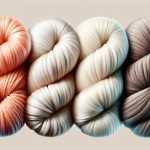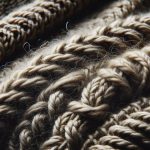The strength of wool comes from its durability and elasticity, letting it bend without breaking. Wool fibers can endure extensive bending, making them tough and long-lasting. This resilience makes wool a reliable choice for textiles that need to withstand wear and tear. Its exceptional durability makes it a popular option for those seeking strong and enduring materials. Wool's combination of durability and flexibility sets it apart from other fibers, ensuring a reliable and sturdy product. Learn more about the exceptional properties of wool and why it's a top choice for various applications.
Table of Contents
Key Takeaways
- Wool fibers withstand bending up to 20,000 times, enhancing durability.
- High staple strength in wool ensures reliable yarn strength.
- Wool's elasticity prevents fiber breakage, combining strength and flexibility.
- Resilience in wool maintains garment shape over time.
- Wool exhibits superior durability compared to other fibers.
Wools Natural Elasticity
With its natural elasticity, wool can withstand bending up to 20,000 times without breaking. Wool fibers possess a unique ability to stretch and flex without losing their structural integrity. This natural elasticity is a key factor in the durability of wool products.
When wool garments are subjected to movement or stretching, the fibers can extend to accommodate the stress and return to their original shape once the pressure is released. This property not only prevents fiber breakage but also helps woolen items maintain their form better than materials lacking such elasticity.
The resilience of wool fibers contributes greatly to the longevity of wool products, making them a reliable choice for various applications. By combining strength and flexibility, the natural elasticity of wool enhances the overall performance and wearability of clothing and textiles, ensuring that they can endure repeated use and retain their quality over time.
Wool Fiber Durability
Wool's durability shines through its ability to withstand 20,000 bends without breaking, and its elasticity prevents fiber breakage, enhancing its strength.
The resilience of wool fibers guarantees that woolen garments maintain their shape over time, outlasting other materials in wear and tear scenarios.
With high staple strength and varying staple lengths determining yarn strength, wool proves to be a durable and reliable choice for long-lasting textiles.
Wool Fiber Resilience
The remarkable durability of wool fibers is evident in their ability to withstand bending up to 20,000 times without breaking. Wool's resilience and elasticity play an important role in its longevity and strength.
Here are three key points to highlight wool's fiber resilience:
- Elasticity: Wool fibers can stretch up to 30% of their original length without breaking, making them highly important to stretching and deformation.
- Shape Retention: Woolen garments maintain their shape well over time, indicating the fiber's ability to bounce back and resist wrinkles or sagging.
- Natural Crimp: The natural crimp in wool fibers adds to their resilience by providing built-in elasticity and springiness, enhancing their durability and longevity.
Wool's innate characteristics make it a durable and resilient choice for various applications.
Wear and Tear
Bouncing back from wear and tear, wool fiber durability showcases its exceptional strength in maintaining shape and resilience over time. Wool can endure bending up to 20,000 times without breaking, highlighting its remarkable durability.
The elasticity of wool fibers prevents breakage, aiding woolen garments in retaining their shape better than other materials. Wool's resilience enables it to conceal signs of wear and tear, making it a durable option for various uses.
The high staple strength of wool fibers, measured in newtons per kilotex, determines their longevity and market value. Even after repeated use, wool maintains its strength and form, establishing it as a reliable and enduring choice for clothing and diverse products.
Wrinkle Resistance of Wool
Utilizing its natural elasticity and resilience, wool fibers minimize the formation of wrinkles in garments. Wool's ability to bounce back to its original shape due to the crimp in its fibers plays a significant role in reducing creases. This, combined with its resistance to bending, helps maintain a wrinkle-free appearance.
Here are three key points highlighting wool's wrinkle resistance:
- Crimp Structure: The unique crimp structure of wool fibers allows them to retain their shape, preventing wrinkles from setting in easily.
- Shape Retention: Wool's inherent properties enable it to resist bending and folding, contributing to its wrinkle-resistant nature.
- Minimal Maintenance: Wool garments require minimal ironing or steaming to look crisp and smooth, showcasing their excellent wrinkle resistance.
Moisture-Wicking Properties
Harnessing its exceptional ability to absorb moisture efficiently, wool stands out for its impressive moisture-wicking properties. Wool can absorb up to 30% of its weight in moisture without feeling wet, making it an ideal choice for activewear and outdoor clothing. This moisture-wicking capability is not only about keeping you dry; it also plays an essential role in regulating body temperature by pulling sweat away from the skin, ensuring comfort in various climates. Additionally, wool's moisture management properties help prevent the growth of odor-causing bacteria, keeping garments fresh even during strenuous activities. The anti-bacterial properties of wool contribute to its overall hygiene and longevity. Thanks to these moisture-wicking features, wool remains a comfortable and breathable option for all seasons, making it a versatile and reliable choice for those seeking performance and comfort in their clothing.
| Moisture-Wicking Properties | Body Temperature Regulation | Anti-Bacterial Properties |
|---|---|---|
| Absorbs up to 30% of its weight in moisture | Regulates body temperature by pulling sweat away from the skin | Helps prevent the growth of odor-causing bacteria |
Wools Temperature Regulation
Wool's temperature regulation abilities make it a standout choice for clothing that keeps you comfortable in varying climates. As someone who values mastery, understanding how wool interacts with body temperature, moisture content, and its insulating qualities is essential.
- Body Temperature: Wool adapts to your body's needs, providing warmth in winter by trapping heat close to your skin and offering breathability in summer to prevent overheating.
- Moisture Content: Wool fibers can absorb moisture without feeling damp, making it ideal for managing sweat and humidity. This moisture-wicking property helps regulate body temperature by keeping you dry and comfortable.
- Insulating Qualities: Wool's natural insulating properties help retain heat during cold weather by creating a layer of warmth, while also allowing excess heat and moisture to escape in warmer conditions.
With its ability to adjust to your body's requirements, regulate moisture, and provide insulation, wool stands out as a versatile choice for all-season wear, ensuring comfort and ideal temperature control regardless of the climate.
Longevity of Wool Products
I find it fascinating how wool products can withstand bending up to 20,000 times without breaking, showcasing their exceptional durability. The resilience of wool fibers plays an important role in the longevity of wool products. This resilience prevents breakage, allowing woolen items to maintain their shape better than those made from other materials. Moreover, wool's ability to hide wear and tear contributes to its long service life, making it a durable choice for garments and other goods.
In addition to its resilience, wool boasts stain resistance properties that help prolong the lifespan of wool products. The natural structure of wool fibers enables them to repel liquids and inhibit the absorption of stains, ensuring lasting quality and reducing the need for frequent washing. This stain resistance not only enhances the durability of wool items but also makes them easier to care for, adding to their overall longevity.
Wools Resilience
With its remarkable ability to withstand bending up to 20,000 times without breaking, wool showcases exceptional resilience in various applications. The elasticity of wool fibers allows them to flex and stretch without snapping, contributing to the overall durability and strength of wool products.
Here are three key points highlighting the resilience of wool:
- Bend without Breaking: Wool fibers can endure significant bending stress without breaking, making them ideal for items that require flexibility and resilience.
- Shape Retention: Woolen garments maintain their shape well over time due to the natural resilience of the fibers, ensuring longevity and continued wearability.
- High Durability: Compared to other fibers, wool exhibits superior durability, which enables wool products to withstand wear and tear, retaining their quality for extended periods.
Wools UV Protection
I want to highlight the incredible UV protection that wool offers.
With a natural UV protection factor of up to 30+, sheep wool is a fantastic choice for shielding against harmful sun rays.
Its ability to absorb and block UV rays makes it a reliable option for safeguarding skin from sunburn and damage.
UV Blocking Properties
Wool's natural UV protection with a factor of 30+ in over 70% of cases shields against harmful sun rays. The surface of wool fibers plays an important role in blocking UV radiation by absorbing and scattering the rays, safeguarding the skin underneath.
- Wool's dense fibers create a crucial barrier that reduces the penetration of UV rays, offering enhanced protection compared to many synthetic materials.
- The inherent structure of wool fibers provides lasting UV-blocking properties, ensuring sustained defense against sun damage over time.
- The UV protection in wool isn't diminished by moisture, making it a reliable choice for outdoor activities under varying weather conditions.
Sun Protection Benefits
Basking under the sun in woolen attire brings a layer of defense against harmful UV rays, safeguarding the skin beneath. Wool's natural UV protection factor of up to 30+ absorbs sun rays, making it an excellent choice for outdoor activities.
Additionally, the waxy coating on wool fibers not only enhances its antibacterial properties but also inhibits mold and bacteria growth. This makes wool a versatile material for clothing, accessories, and outdoor gear, providing both sun protection and added durability.
When engaging in outdoor activities, choosing wool items can help shield your skin from sun damage, allowing you to enjoy the outdoors while staying protected. Wool truly offers a unique combination of UV protection and comfort for all your outdoor ventures.
Antibacterial Properties of Wool
With its natural waxy coating containing antibacterial fatty acids, wool inhibits the growth of mold and bacteria effectively. This unique feature of wool sets it apart from other materials, making it a popular choice for various products.
- Natural Protection: Wool's waxy coating acts as a natural barrier against bacteria, reducing the need for frequent washing and chemical treatments that can harm the environment.
- Odor Control: The antibacterial qualities of wool help prevent odors from developing, ensuring that woolen items stay fresh even after extended use.
- Durability: By inhibiting the growth of mold and bacteria, wool's antimicrobial properties contribute to the material's longevity and overall durability.
Stain Resistance of Wool
I've always admired how wool's natural stain repellent properties make it easy to keep clean. Spills bead up on woolen items, making it simple to wipe away stains effortlessly.
This stain resistance, along with wool's durability, truly sets it apart as a practical choice for both clothing and home furnishings.
Natural Stain Repellent
Effortlessly repelling liquids and wiping off stains with ease, wool's natural stain resistance makes it a practical choice for maintaining cleanliness and freshness.
Wool's stain resistance stems from its natural fibers and the waxy coating that covers them, forming a protective barrier against spills and stains. This unique feature not only prevents liquids from penetrating the fabric but also makes cleaning up spills a breeze.
The waxy coating on wool acts as a shield, keeping static, dirt, and stains on the surface, making woolen items less prone to looking soiled. Due to its remarkable stain-repellent properties, wool garments require less frequent washing, making them both convenient and sustainable options for a variety of uses.
Easy to Clean
Wool's natural stain resistance, attributed to its waxy coating that repels liquids and prevents stains from penetrating fibers, makes cleaning spills a simple task. The surface of wool inherently repels water, causing spills to sit on top rather than seep in. This quality prevents stains from being absorbed, allowing for easy removal with a quick wipe.
Due to its ability to resist stains and repel liquids, wool items like rugs and clothing require less frequent washing. The outer coating acts as a barrier, making it easier to maintain the cleanliness of wool products.
With wool's natural stain resistance, cleaning up spills becomes a hassle-free process, ideal for those seeking practical and low-maintenance solutions.
Durable Against Spills
With its inherent ability to repel liquids and prevent stains from setting in, wool proves to be exceptionally resilient against spills, showcasing its remarkable stain resistance. When it comes to durability against spills, wool excels in several key areas:
- Natural Repellent: Wool's outer coating acts as a natural repellent, causing spills to bead on the surface rather than seeping into the fibers.
- Ease of Cleaning: Stains on wool can be effortlessly wiped off, thanks to its natural stain resistance, keeping garments looking fresh and clean.
- Long-lasting Appearance: The waxy coating on wool not only prevents stains but also static and dirt from being absorbed, helping maintain the material's appearance over time.
Wool's ability to resist spills and stains contributes to its reputation for durability and easy maintenance.
Frequently Asked Questions
Does Wool Have Strength?
Yes, wool possesses remarkable strength due to its staple strength measured in newtons per kilotex. This metric determines its resistance to breaking, essential for wool quality, price, and durability in various products.
What Are the Strengths and Weaknesses of Wool?
Wool's strengths include durability, elasticity, insulating properties when wet, fire resistance, and stain repellency. These qualities make it a reliable and practical choice for garments. Understanding its weaknesses helps appreciate wool's overall value.
Is Wool Strong or Not?
Wool is unquestionably strong. Its fibers can bend thousands of times without breaking. The elasticity in wool prevents easy breakage and helps it maintain shape. Wool's staple strength, measured by force required for breakage per unit thickness, showcases its durability.
What Makes Wool Strong?
To understand what makes wool strong, consider its staple strength and elasticity. Staple strength, measured in newtons per kilotex, determines durability. Wool's elasticity prevents breakage. Staple length also influences strength, essential for weaving or knitting.
- Does Chiffon Fabric Stink - July 15, 2025
- Does Chiffon Fabric Affect the Economy - July 15, 2025
- Does Cotton Fabric Have a Nap - July 15, 2025







